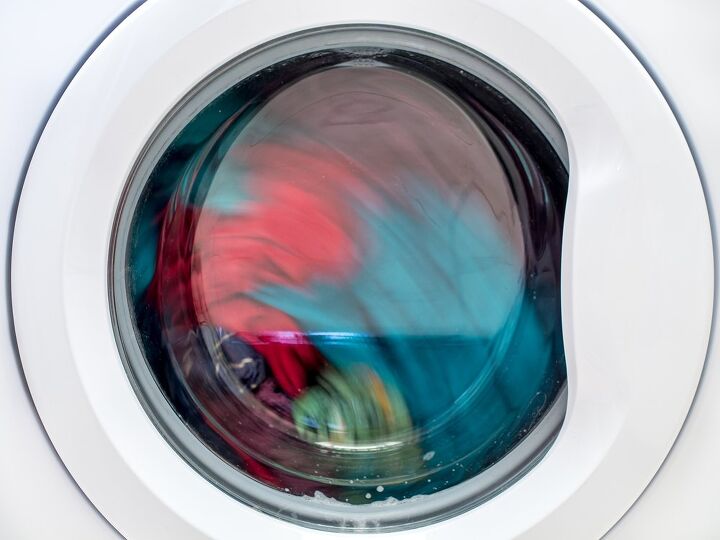Washer Spins But Clothes Are Still Wet? (Possible Causes & Fixes)

Your washing machine is one half of the equation that makes getting your laundry done conveniently. Load the washer, add the soap, and switch it to the appropriate setting and your washing machine will do the rest.
But there may come a time where you pop open the lid and your clothing is still completely soaked. What gives? There are a few reasons why your clothing may still be soaked even after it has gone through a complete cycle. It could be due to improper drainage or an underpowered spin. You may have a loose valve or, in the worst case, you could be facing a cycle control problem, which may require a technician to fix.
Do You Need Appliance Repair Services?
Get free, zero-commitment quotes from pro contractors near you.

The Spin Cycle
Before we get started, a little bit into how your washing machine works. When you start the machine, the tub fills with water. This soaks your clothes and allows the soap to saturate them. The clothes are then cycled around the tub to create friction, which cleans the clothes.
But before your clothing comes out, it goes through a spin cycle. The spin cycle uses centrifugal force to wring all of that excess water out of your clothing. The result is that your clothes come out of the washer clean but with only a little extra moisture.
When the clothes come out overly saturated with water, they should not go into the dryer. For starters, it is an indication that there may be something wrong with your washing machine. Secondly, clothes that are soaked could have a negative impact on your dryer as well. Let’s figure out the potential issue with the spin cycle instead.
Why is the Washer Spinning but My Clothes are Still Wet?
When your clothing comes out of the washing machine but is still saturated with water, it is not an ideal situation. In the best of cases, you will have to run the spin cycle again. What you are more likely facing, however, is a potential issue with the washing machine.
There are five issues in particular that could be at play. It may or may not need repair depending on what the issue is. Only through troubleshooting can one hope to effectively identify the issue and resolve it.
Drainage Issues
One of the most common issues has to do with drainage. When your washing machine can’t properly drain, it doesn’t matter how fast the drum spins. That water remains trapped in the drum and gets saturated into the clothing. It may even remain pooled in the drum after the cycle has finished.
The most common issue with drainage is a clogged drain. The good news is that it is also the easiest to remedy. You can usually get by with clearing the drain filter or snaking it. Having a technician come out to disassemble and clear the clogs may also be a smart move.
The problem could also be that the drain pump is weak. That means that your water is struggling to pump out the water during the spin cycle. This isn’t the same as a clog. It more than likely means needing a new drain pipe altogether.
Finally, there is drain siphoning. When the washer pulls some of the water back out of the drain and into the tub, that is siphoning. That means extra water being added to the tail end of the spin cycle, which essential re-soaks the clothing in the tub.
Oversudsing
Another of the most common issues with washing machines not properly spinning is having too much soap. This process is known as oversudsing and happens when you put way too much detergent into the washer.
When there is too much detergent, there are too many bubbles. This is one of the simplest explanations and is usually apparent because bubbles will come out of the lid and drip onto the floor of your wash room.
The issue of oversudsing could also cause the suds lock to trip. Those bubbles can form a pocket of air between the wall of the washer and the clothing. When the tub spins, the clothing spins slowly which lessens the friction. Do yourself a favor and use high-efficiency detergent in your loads. They are meant to provide a different concentration than non-HE detergents and ensure that the washer runs properly.
Underpowered Spin
There is, of course, the chance that your washing machine’s spin just doesn’t have enough power behind it. A good indicator is that your clothing is still soaked but there is no standing water in the bottom of the tub. It could be possible that you set it to a low spin, but it is usually a mechanical problem at fault.
The mechanical issues could be the clutch, tub bearings, motor pulley, or a bad belt. The belt is what allows the drum to spin as fast as it does. It sits on a number of pulleys that are connected to either the back or bottom of the drum, providing the necessary torque for the spin.
The most critical component is the clutch. Coupled with the bearings, these ensure that the tub can spin smoothly regardless of how fast it is moving. When one of these components breaks, it can create critically low speeds if that function works at all. This is a problem best left to appliance repair technicians as it can be quite complicated to get into the inner workings of a washing machine.
Cycle Control Issues
There is also the chance that there is an issue somewhere within the machine’s control panel. When there is a problem with the control panel, it may not be triggering the spin cycle at all. Or perhaps the timer doesn’t get to the spin cycle before thinking the load has finished.
Keep in mind that your washing machine has certain triggers that can cause the washer door to open. When the door opens, that will stop the spin cycle. It could be outdated software, damaged hardware, or an incorrect setting. Here are the three main control problems to be aware of.
Loose Power Cord
Though it sounds simple, this is on the list for a reason. Check the power cord and see if it is properly plugged in. If it is loose, try pushing it into the socket further to properly secure it. With as much shaking and vibration as occurs with a washing machine, it is possible for a loose plug to slowly migrate out of the socket.
Loose Latch
Your washing machine won’t run if the door doesn’t shut. This is triggered through the door latch. Test it and make sure that it closes firmly, with the door switch kicking on. Should the latch be faulty or loose, it can shake open.
When the door is able to shake open even a little, it might interrupt the spin cycle. Interruptions to the spin cycle can keep it from properly pulling out the excess water in your clothing.
Malfunctioning Control Panel
Finally, if you have gotten this far, then it may be the control panel itself that is at fault. You could be staring down either a software or hardware issue, but this is the last-ditch option. More often than not, when the control panel is faulty, it will need to be replaced entirely.
It is highly recommended that you bring in a professional to handle control panel issues. This is one of the more complex fixes and is usually outside the scope of DIYers.
Water Inlet Valve is Loose
The final thing that you want to check out is whether your washing machine has spring some kind of internal leak. When there is an internal leak, water will drop into the tub and eventually soak your clothing through.
The inlet valve is what determines whether or not water can flow into the washer from the cold-hot tap that comes out of the wall. When the inlet valve is loose, water will drip down into the drum. Give that leak enough time and it will soak your clothes.
Most of the time, you can simply tighten the inlet valve to solve the problem. But if need be, consider replacing the valve entirely. That should stop the leak from happening and will at least eliminate one more possibility.
Do You Need Appliance Repair Services?
Get free, zero-commitment quotes from pro contractors near you.

Final Thoughts
Your washing machine is a complex appliance. There are a lot of moving pieces and parts. When one of them malfunctions or stops performing properly, it can make doing a regular load of laundry difficult or outright impossible.
The simple issues – loose latches, clogged drains, and oversudsing – can be resolved by even the most novice of DIYer. But when you start getting into the more complicated mechanical and electrical issues, it is always advised that you bring in a professional.
A professional has the skills, knowledge, and experience to not only properly troubleshoot the issue but bring about a fix in short order. They can save you a lot of time and frustration that would have been spent trying to figure out the issue on your own.

Ryan Womeldorf has more than a decade of experience writing. He loves to blog about construction, plumbing, and other home topics. Ryan also loves hockey and a lifelong Buffalo sports fan.
More by Ryan Womeldorf



























